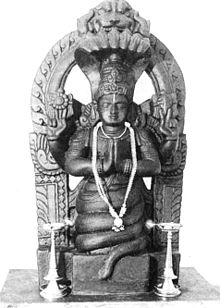
Back Yoga Sutra van Patanjali Afrikaans Yogasutra ALS يوغا سوترا Arabic পতঞ্জলিৰ যোগসূত্ৰ Assamese Йога сутра Bulgarian पतंजलि योग सूत्र Bihari পতঞ্জলির যোগসূত্র Bengali/Bangla Ioga sutra Catalan Pataňdžaliho jógasútra Czech Swtrâu Ioga Patanjali Welsh

| Part of a series on |
| Hindu scriptures and texts |
|---|
 |
| Related Hindu texts |
| Part of a series on | |
| Hindu philosophy | |
|---|---|
 | |
| Orthodox | |
|
|
|
| Heterodox | |
|
|
|

The Yoga Sutras of Patañjali (IAST: Patañjali yoga-sūtras) is a collection of Sanskrit sutras (aphorisms) on the theory and practice of yoga – 195 sutras (according to Vyāsa and Krishnamacharya) and 196 sutras (according to others, including BKS Iyengar). The Yoga Sutras were compiled in the early centuries CE, by the sage Patanjali in India who synthesized and organized knowledge about yoga from much older traditions.[1][2][3]
The Yoga Sutras is best known for its reference to ashtanga, eight elements of practice culminating in samadhi. The eight elements are yama (abstinences), niyama (observances), asana (yoga posture), pranayama (breath control), pratyahara (withdrawal of the senses), dharana (concentration of the mind), dhyana (meditation) and samadhi (absorption or stillness). The main aim of practice is kaivalya, discernment of purusha, the witness-consciousness, as distinct from prakriti, the cognitive apparatus, and disentanglement of purusha from prakriti's muddled defilements.
The Yoga Sutras built on Samkhya notions of purusha and prakriti, and is often seen as complementary to it. It is closely related to Buddhism, incorporating some of its terminology. Samkhya, Yoga and Vedanta, as well as Jainism and Buddhism, can be seen as representing different manifestations of a broad stream of ascetic traditions in ancient India, in contrast to the Bhakti traditions and Vedic ritualism which were prevalent at the time.
The contemporary Yoga tradition holds the Yoga Sutras of Patañjali to be one of the foundational texts of classical Yoga philosophy.[4][5] However, the appropriation – and misappropriation – of the Yoga Sutras and its influence on later systematizations of yoga has been questioned by David Gordon White,[6] who argues that the text fell into relative obscurity for nearly 700 years from the 12th to 19th century, and made a comeback in the late 19th century due to the efforts of Swami Vivekananda, the Theosophical Society and others. It gained prominence as a classic in the 20th century.[6]
- ^ Wujastyk 2011, p. 33.
- ^ Feuerstein 1978, p. 108.
- ^ Tola, Dragonetti & Prithipaul 1987, p. x.
- ^ Whicher 1998, p. 49.
- ^ Stuart Sarbacker (2011), Yoga Powers (Editor: Knut A. Jacobsen), Brill, ISBN 978-9004212145, p. 195.
- ^ a b White 2014, p. xvi–xvii.